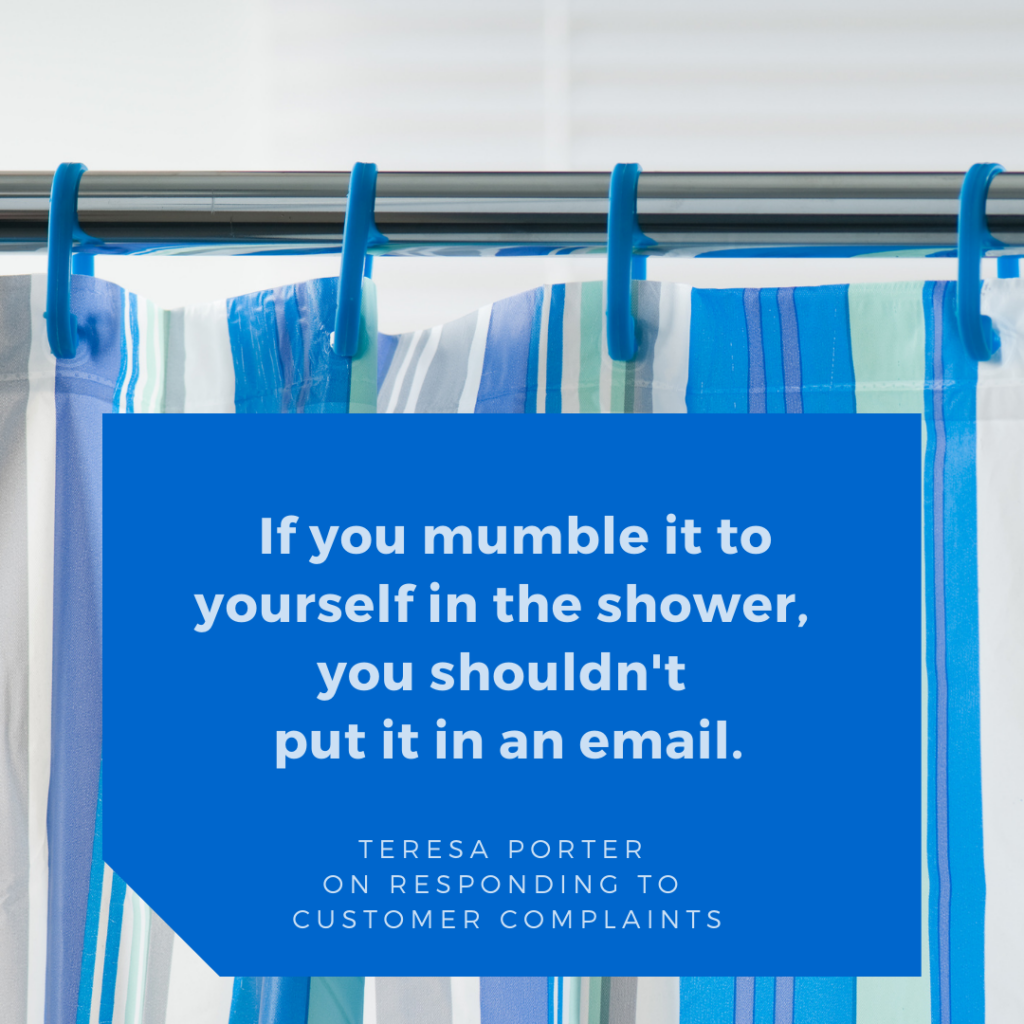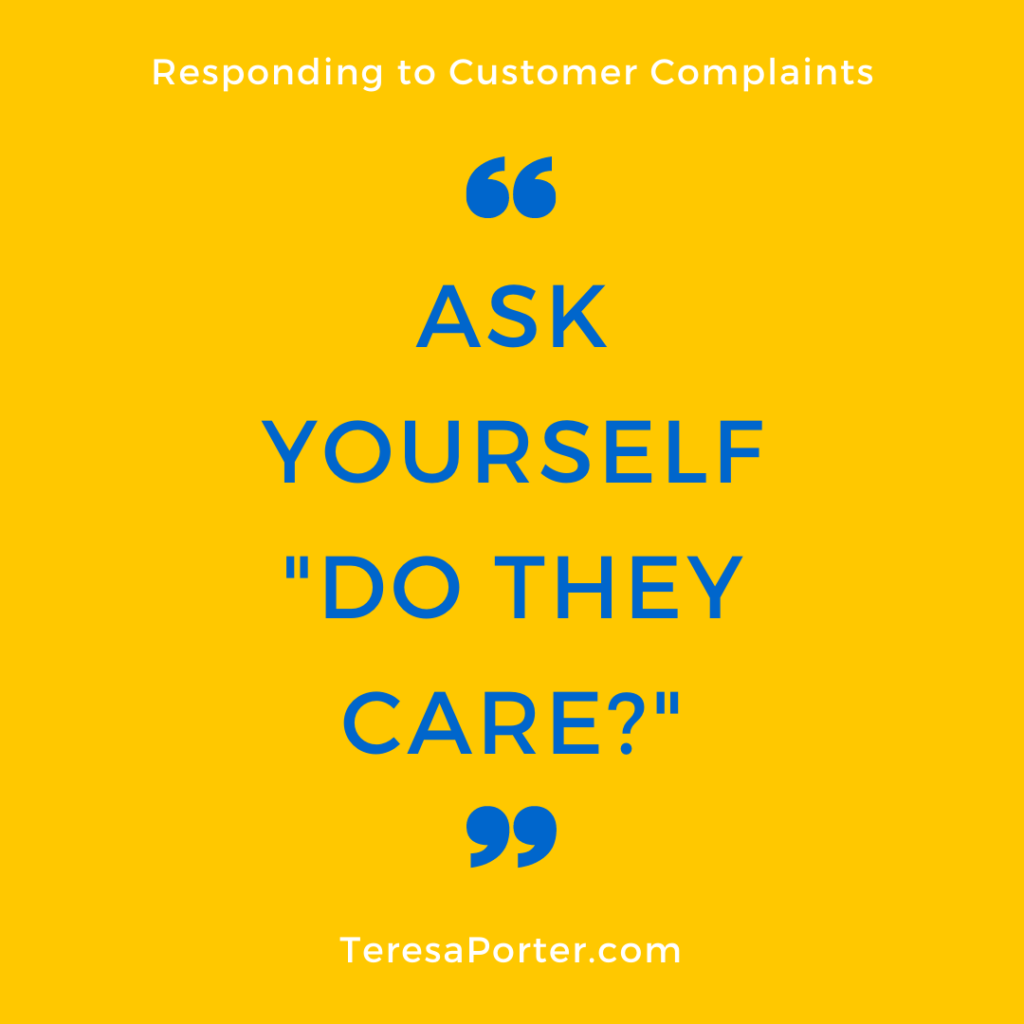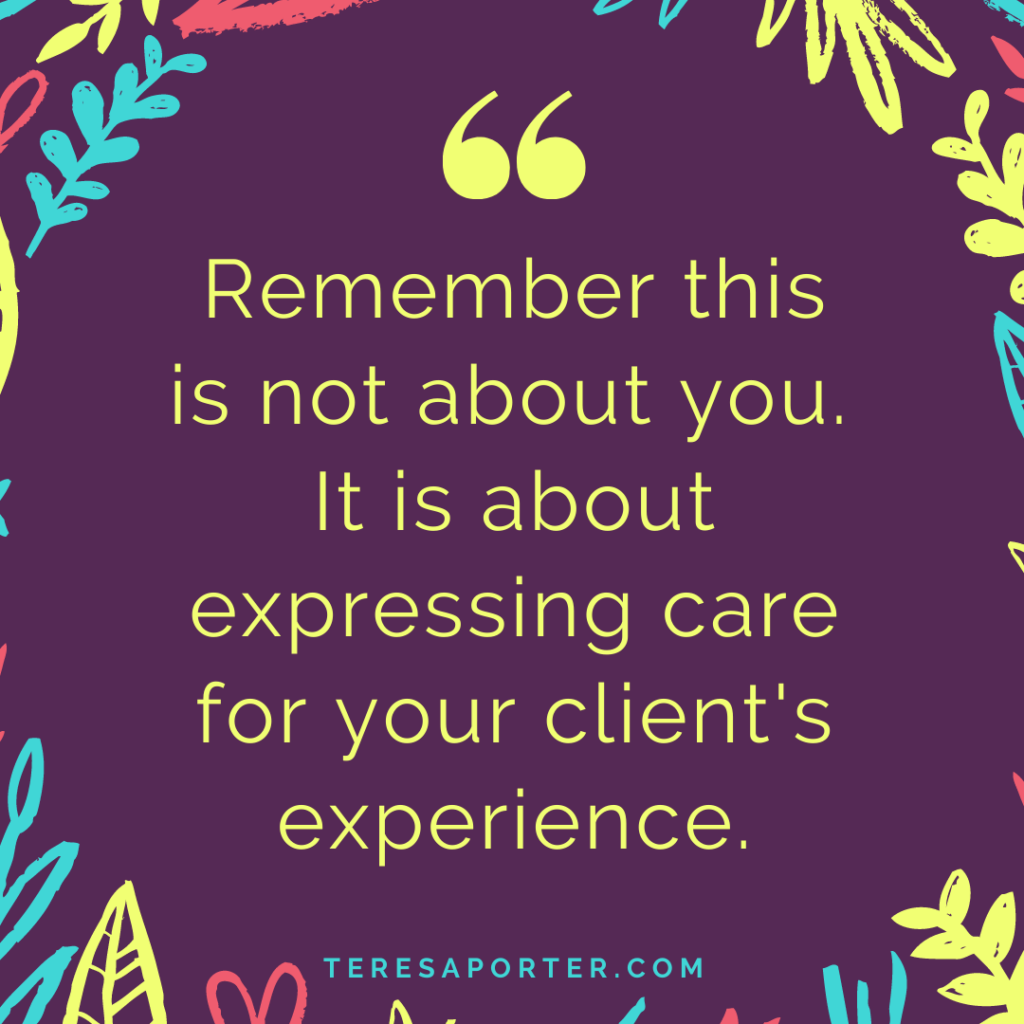An easy guide to responding to customer complaints by email.
Responding to customer complaints wasn’t how I thought my day was going to get started but I should have known it was going to be a tough day when I woke up two minutes before my alarm clock with a feeling of dread. I felt around under my pillow for my phone and held it up to my sleep-crusted eyes for facial recognition. Side note, are we sure these aren’t being saved somewhere?
Instead of opening my day with affirmations, or my soul to the day’s possibilities, I like to open my email. Today is no different, and before I’ve even stood up I’m running through my day.
Then I see it. This email. Do you ever get an email like this from a customer and think, oh great, now I am going to spend my whole day responding to customer complaints?
Hi Teresa – I’m sorry to have to write this email but we need to cancel our session with you for October. I understand why you weren’t able to do our original date with the rain and all but I can’t get the new date to work with hubby’s work schedule. I’m also surprised to learn your pricing is so out of line with what other photographers charge (really good ones!). From asking around the office most people seem to pay $200 – $300 for a session that includes everything. I know you do a lot more and have more experience but I just can’t justify it. I do have to say I find it frustrating you didn’t tell me other photographers don’t charge this much. Please send a refund and cancel our contract right away. Can you give me a referral for someone else that’s good / has a similar style but doesn’t charge for all these extras?
My anxiety is already pumping before the daily anti-anxiety medication hits my tongue. My brain thinks I’m running from lions even though I’m just waiting for the shower to heat up. I rehearse several versions of my non-approved response during the shower. Except, in that shower I am the reality-show tell-all version of myself delivering insults, explanations, justifications and all manner of reading her to filth. If you mumble it to yourself in the shower, you shouldn’t put it in an email. “Out of line”? “$200 – $300 sessions?” “frustrated I didn’t tell you others charge that much…”. The crescendo of my take down – “A REFERRAL FOR SOMEONE THAT IS ME BUT CHEAPER?”.

When I get to the Studio for the day it’s time to start responding to the customer complaint. My shower confessional has me fueled up with lots to say. I am tempted to write a long email that explains why she is mistaken about other’s pricing, why you can’t compare two photographers like two different kinds of toilet paper. I wanted her to know all about my cost of doing business and the importance of photography. I wanted to know she understood the investment in her portraits would be way less than the mortgage on her 2nd home and would bring more enjoyment. Of course, none of those things are really for me to say.
Responding to customer complaints can be easier than you think.
The number one rule of responding to customer complaints is asking yourself: “Do they care?”
Does this client care about my cost of doing business? My years of continuing education and experience? That I am different from other photographers? No. She doesn’t care. She doesn’t need to care. She wants a service at a price I can’t match. That is all. It’s business.

It is business, yes, but it can feel deeply personal. I want to explain myself, justify my pricing, and defend my way of doing business. I want to feel understood and validated. This client has me off balance in a relationship that I thought was solid. What I want is to reconnect with this client both personally and as a business. I want to put the pieces of our service-client relationship back together so that everything feels OK again. I am terribly uncomfortable and wonder why doesn’t she like me? Is she telling everyone I’m awful?
Have you been there? Do you know that rock-in-your-throat feeling? Ever have a day where you feel like all you are doing is responding to customer complaints? Trying to figure out the right way to respond to customer complaints to ‘win’ them back? The self doubt and anxiety? It doesn’t happen often but when it does, it is consuming.
I’ve developed a recipe for responding to customer complaints that happen over email. Having a formula helps me stay on script and keeps me from wandering off into the briar patch of explaining, justifying, and defending.
A guide to responding to customer complaints
First – let’s start with that one.
Never explain, justify, or defend. If you are in a position to have to do any of those three things you have already lost.
Explaining, justifying, and defending in response to customer complaints just opens the door for a back and forth conversation that really doesn’t need to happen. I could tell you so much more about this but it will have to wait for another blog post. For now just make sure nothing you write is to explain, justify, or defend your position.
The next one is so obvious it still has to be said.
Keep it short.
If you’ve wandered into “who cares” territory then tighten it up. If you need to type more than a few paragraphs you should probably be having this conversation over the phone.
So what is this fail-proof formula for responding to customer complaints?

EMPATHY
Open with an empathetic statement that reflects back to your client their emotions. My client expressed frustration and that gives me the opportunity to let her know that I can empathize with feeling frustrated. It is equally important not to express empathy for things they haven’t mentioned. If your client hasn’t said they are angry, don’t assume they are angry. Printed words have no emotions, we bring our own feelings to the written word. Remember this is not about you. This is about expressing care for your client’s experience.
Examples of expressing empathy when responding to customer complaints might be:
“I understand how frustrating this might feel . . .”
“If I’m hearing you correctly . . . “
“It seems as though . . .”
“I would feel xxxx in this situation too…”
GRATITUDE
Finding a way to express gratitude to your client in the middle of a conflict is powerful. This is even more powerful when you’re able to turn your energy to truly feeling grateful. Am I happy this client is moving on? No, I want their business. Am I grateful that they excused themselves from the process before our session? Yes. Am I grateful that my process for making sure everyone is clear on investment works? Yes. Am I grateful they are still going to pursue getting photographs even if it isn’t with me? Yes. Find the gratitude and express it.
Some examples of expressing gratitude in responding to customer complaints are:
“I am so glad you took the time to write this . . .”
“I am very grateful you have trusted me with this sensitive information, talking about xxxx is never easy.”
“Thank you for bringing this to my attention
“Thank you for mentioning it, I wouldn’t want it to be this way …”
“I’m glad to hear you’re still getting service, even if it isn’t with me . . .”
Note that the “empathy” and “gratitude” steps of an email can be flip flopped but should always go together and come before the hard truth part of your email.
TRUTH
Every customer conflict has a baseline truth that is in disagreement; a hard boundary that is the end of the line in negotiations. This boundary, rule, or tough talk is the truth part of your email and most of us do it all wrong. We either add flowery language to soften the force of what we are saying or we are so devoid of feeling and connection that it can feel stern and curt, leaving no room for humanity. The perfect email opens with feeling (empathy and gratitude) and then delivers the facts as facts. It is not your job to tell the client what they want to hear. It is your job to deliver the truth in a way that is clear.
Some examples of how to deliver the hard truth when responding to customer complaints are:
“You may remember . . . “
“Unfortunately . . . “
“Although it makes me uncomfortable to not be able to be more flexible . . .”
“As much as I’d like to . . . “
PERSONAL TOUCH / PROMISE
Resist the temptation to soften the truth statement in this part. This is your chance to remind the client that you are a person too. If you’ve had an existing relationship with the client this is a great time to pull from that memory. If you haven’t gotten to know them or this is early communication you can still add a personal touch. Personal touches are relatively lighthearted, conversational in tone, and are used to bring both people back to a place of humanity. Alternatively or in addition, this is a great time to mention a promise you intend to keep – in this case, the promise of the return of her session fee and cancelation of her contract.
Some examples of adding a personal touch when responding to customer complaints are:
“I can’t wait for you to see the pictures of him with his hat . . .”
“Time to go put up the Christmas decorations before they sit in my closet all year (again!) . . .”
“I hope Tommy got the m&ms he was so excited about. I think the yellow ones taste the best…”
“You can expect xxxxx from me by xxxx. Let me know if you don’t see it by xxxx.”
INVITATION TO CONVERSATION
The best way to conclude your email is with an invitation to them to talk by phone if they have any lingering questions or concerns. The critical part of this exchange is to specify any further conversation would happen by phone. You want to avoid a back and forth over email where everyone can read different tone and people tend to feel a lot more emboldened to say things they wouldn’t normally. An added bonus is phone conversations usually happen during business hours where people are at their best, most sober, and most professional.
This is as simple as “If you have any lingering questions or concerns, give me a call (xxx-xxx-xxxx).”
Example Response to Customer Complaints
So let’s look at an example of my response to the customer complaint above using the email template of empathy, gratitude, truth, personal touch, and invitation to further conversation.
Dear xxxxxx, Thank you for reaching out to me; I appreciate you letting me know you want to cancel your session and for letting me know your frustration at our pricing compared to other photographers. You may remember that we discussed our pricing and experience during your initial phone call and planning meeting; while we didn’t offer you explanations of other people’s pricing (truthfully, I’m not sure I’d even know how to do that) we gave you all the information we could about our own process and associated cost. With that said, what is most important is that we are a good fit for your family and with that in mind I’ll cancel your session and process your refund back to the card on file. I know you were really looking forward to having photographs of your family for the holidays and even if it isn’t with me, I am glad you are still doing a session. I don’t know anyone I can confidently refer to you in the price range you mentioned but I wish you the best of luck and a great holiday season. If you have any lingering questions, please give me a call (xxx-xxx-xxxx). Kind Regards, Teresa
Note: In this case my hard truth wasn’t so hard after all, I was going to issue the refund per her request. If I wasn’t going to give her a refund my answer would have been slightly different but still just as clear. “You may remember that your session fee is a non-refundable retainer for your individual session day. I cannot give you a refund on that session as I am unlikely to book the date and this is the policy we discussed in your initial phone call, planning meeting, and the contract.”
What do you think?
How would you feel as a client if you got that email as a response? You would feel understood, appreciated, clear on boundaries, reconnected, and invited to keep talking if needed. While you might not like the answer or the boundaries it has all been communicated in a clear and professional way that doesn’t leave the door open for back and forth negotiations.
When I was writing emails in my head during my shower, they were nothing like this. Emotion in the heat of the moment, loaded with anxiety, frustration, or hurt is never the right time to respond. By avoiding explaining, justifying or defending and asking myself “do they care?” I was able to keep this response to customer complaints on track. My formula for empathy, gratitude, the hard truth, personal touch, and invitation to communication helped me compose a measured and professional response. Try it out and let me know how it works for you when you’re writing your next response to customer complaints.
Are you a business owner in need of a squad?
If you’re anxious, artistic, awkward, or amazing and own a business then we’d love to have you in our Facebook Group. Live conversations, free webinars, podcasts, videos, and occasionally inappropriate language are all available.


Can I just forward all of the emails I get like this to you?! Great read and wonderful insight!
Well said! I love how you give a template email. Everybody needs this kind of support in business, just as you’ve given it. First there’s management of our own feelings (and how deeply we care), a key step before we execute professional communications. Thank you!